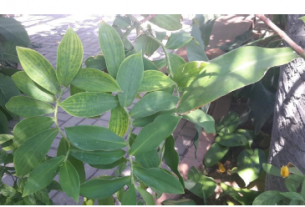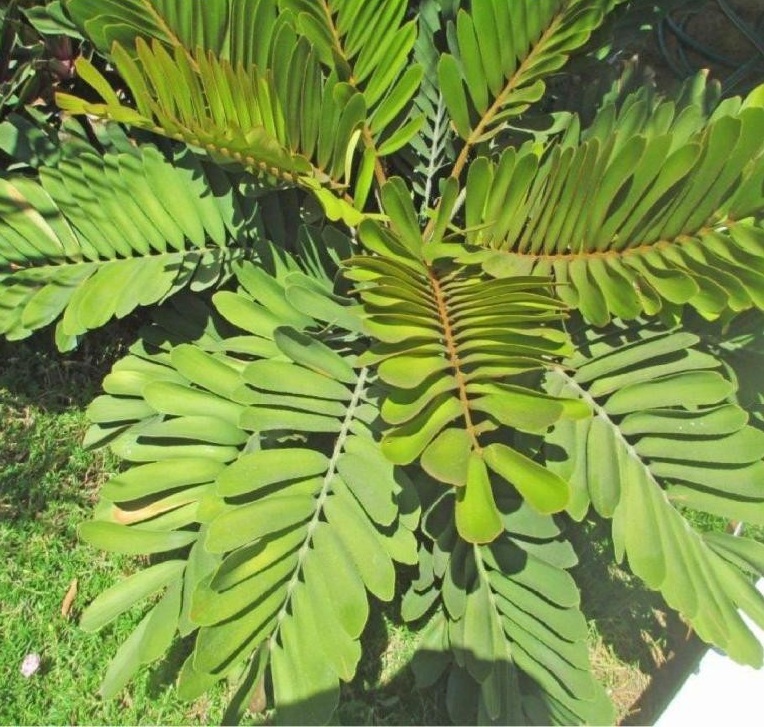By Tommy Clarkson from the December 2015 Edition
Lady Palm, Rhapis excelsa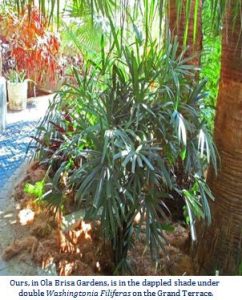
Family: Arecaceae
(Also known as Bamboo Palm, Miniature Fan Palm, Little Lady Palm, Large Lady Palm, Slender Lady Palm, Broadleaf Lady Palm, and Ground Rattan)
With what I’m about to say, you’ll probably think that I’m pulling your proverbial leg but, honestly, I’m not!
All of my research has borne out a common assertion. In recent history, this palm has never been found in the wild! All of the known plants from whence it comes as Riffle describes them are “cultivated individuals in China”. . . the determination of such I leave to your own, individual imaginations!
Believed to have originated in the southern portion of the “Land of the Sleeping Dragon” , this smallish, clumping, slow growing, species is one of twelve in the Rhapis genus. And while it’s not polite to discuss a lady’s girth, the clump width of the Rhapis excels is, for all intents and purposes, unlimited in that it spreads by rhizomes – which you probably remember are horizontally creeping underground stems. These clumps can consist of 100 or more stems. Widthwise, that can make for one rather hefty lady!
Sometimes leading to confusion, both this lovely species and the R. humilis are often called Lady Palms. Popular for both garden use as a privacy screen and planter/pot venues it also makes a nice indoor specimen. In fact, this is one of the very best small palms for use inside your home. Our lovely, thriving,
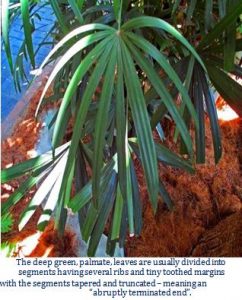 Ours, in Ola Brisa Gardens, is in the dappled shade under double Washingtonia Filiferas on the Grand Terrace. specimen is in the dappled shade under double Washingtonia filiferas on the Grand Terrace, here at Ola Brisa Gardens.
Ours, in Ola Brisa Gardens, is in the dappled shade under double Washingtonia Filiferas on the Grand Terrace. specimen is in the dappled shade under double Washingtonia filiferas on the Grand Terrace, here at Ola Brisa Gardens.
Interestingly, though it carries the Latin epithet for “tall”, it is not by a significant margin -the proverbial beanstalk in the genus.
The deep green, palmate, leaves are usually divided all the way to their base into segments with each of these having several ribs and tiny toothed margins. (In botanical parlance, margin means the border of the leaf.) The segments are tapered and truncated meaning an “abruptly terminated end”. We, of the less than wholly scientific community, might think of these segments as the palm fronds long and slender “leaflets”. These segments may vary in number and width on each plant.
Generally speaking, its slender almost reed-like stems, of no more than an inch thick, are covered with persistent leaf bases that, ultimately, break down into a web of dark fibers. The older stems, once becoming bare, exhibit rings. These stems can reach three meters or so (10’).
The male and female inflorescences (flowers) are on different plants. These flowers emerging from two papery bracts present themselves in a spiral arrangement on the rachillae, which is a specific branch whose only job is to support these flowers. From these flowers come their small, white and globular fruits which are round and .3 inches (7 ½ cm) in diameter.
As to environs in which these slow growers thrive, find or create humusy soil with good drainage, ample 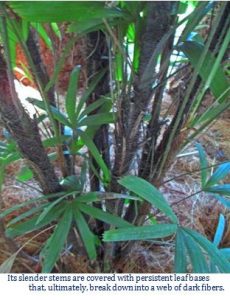 humus and fertilizer in filtered bright light. They like water and humidity and are neither drought nor salt tolerant which means that we suggest maintenance of a good watering schedule and not being planted too near the beach! On the other side of the botanical coin, the Lady Palm has few nutrition, disease or insect problems.
humus and fertilizer in filtered bright light. They like water and humidity and are neither drought nor salt tolerant which means that we suggest maintenance of a good watering schedule and not being planted too near the beach! On the other side of the botanical coin, the Lady Palm has few nutrition, disease or insect problems.
Allow me to gush yet further on the many virtues of this lovely small palm. It’s almost without equal as a “seen close-up” palm where its grace and form can be fully appreciated. (To better enjoy its superlative silhouette it is wise to remove some of the crowded trunks.) It is also a great selection for placement near water. However, all of the preceding having been said, such is its own self confidence that it, generally, can handle neglect and abuse with but the lightest of a shudder of one of its fronds!
Repeating early cited data this is certainly one of those hardy, “Let’s grow one inside back in chillier climes” palms! Though it is supposedly a tropical plant, it has no difficulties with temperatures in the low 20s (F). Going yet further, it is known to have resprouted, from its rhizomes, even after its stems were killed all the way to the ground by the cold.
However, prepare to be confused should you go to a nursery as you may be faced with an array of small, different palms that look similar. Japanese horticulturists have developed numerous dwarf varieties of Rhapis excelsa some, even, with variegated leaves!
For back issues of “Roots”, gardening tips, tropical plant book reviews and videos of numerous, highly unique eco/ adventure/ nature tours, as well as memorable “Ultimate Experiences” such as Tropical Garden Brunches
Download the full edition or view it online
—
Tommy Clarkson is a bit of a renaissance man. He’s lived and worked in locales as disparate as the 1.2 square mile island of Kwajalein to war-torn Iraq, from aboard he and Patty’s boat berthed out of Sea Bright, NJ to Thailand, Germany, Hawaii and Viet Nam; He’s taught classes and courses on creative writing and mass communications from the elementary grades to graduate level; He’s spoken to a wide array of meetings, conferences and assemblages on topics as varied as Buddhism, strategic marketing and tropical plants; In the latter category he and Patty’s recently book, “The Civilized Jungle” – written for the lay gardener – has been heralded as “the best tropical plant book in the last ten years”; And, according to Trip Advisor, their spectacular tropical creation – Ola Brisa Gardens – is the “Number One Tour destination in Manzanillo”.


